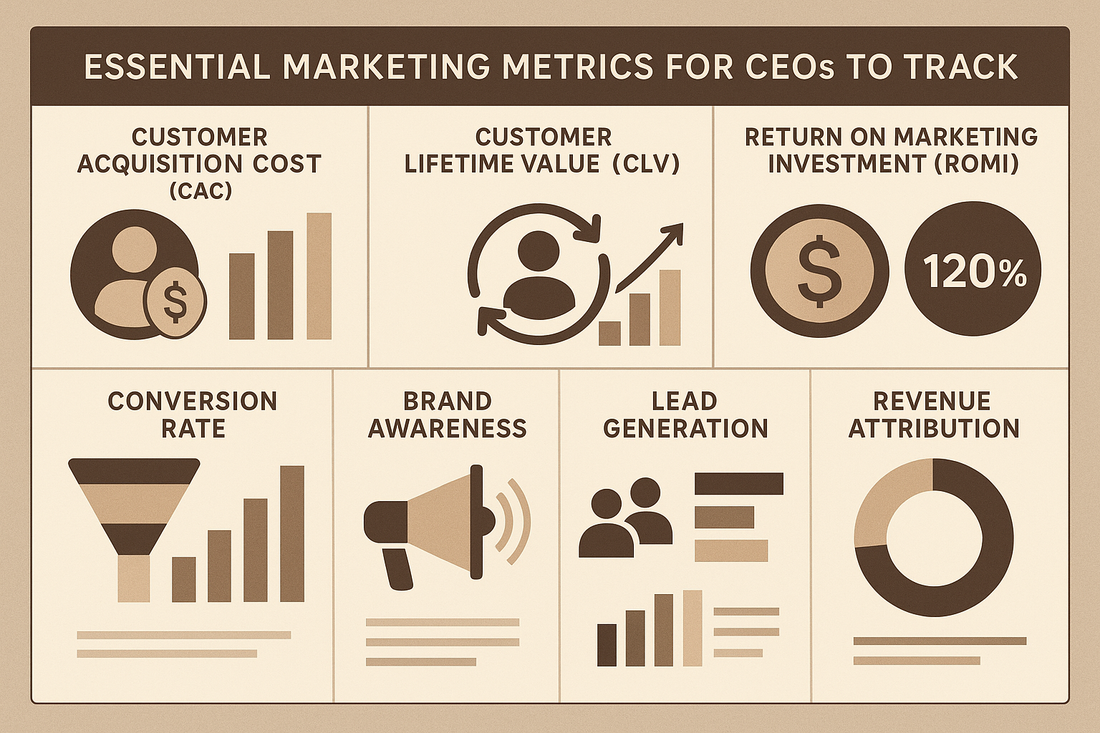
5 Marketing Metrics Every CEO Should Track in 2025 to Drive Growth
Share
In 2025, marketing is no longer a department working in isolation — it’s a growth engine that must be aligned with your company’s strategic objectives. As a CEO, you can’t afford to be disconnected from your marketing data. The right metrics will help you make informed decisions, allocate resources effectively, and keep your team accountable for growth.
This post highlights five key marketing metrics every CEO should be tracking, why they matter, and how to use them to drive results.
1. Customer Acquisition Cost (CAC)
What It Is:
The total cost of acquiring a new customer (ad spend, salaries, software, etc.) divided by the number of customers acquired.
Why It Matters:
CAC tells you how efficient your marketing and sales process is. If your CAC is too high compared to your customer lifetime value (LTV), profitability will suffer.
CEO Action Tip:
Monitor CAC trends monthly. A sudden spike may indicate wasted ad spend, poor targeting, or a sales funnel problem that needs attention.
2. Customer Lifetime Value (CLV or LTV)
What It Is:
The total revenue you can expect from a single customer over the course of your relationship with them.
Why It Matters:
If you know your LTV, you can decide how much to invest in acquiring new customers. A high LTV means you can spend more on marketing while staying profitable.
CEO Action Tip:
Aim to increase LTV through retention strategies — subscriptions, loyalty programs, and upsell offers.
3. Marketing Qualified Leads (MQLs) and Conversion Rates
What It Is:
MQLs are leads who have engaged with your brand (downloaded a resource, booked a call) and fit your target audience profile. Conversion rate measures how many become paying customers.
Why It Matters:
High MQL volume with low conversion rates signals a quality issue, you’re attracting the wrong audience.
CEO Action Tip:
Review MQL-to-customer conversion rates quarterly. Push your team to refine targeting and messaging if numbers dip.
4. Return on Marketing Investment (ROMI)
What It Is:
Revenue generated from marketing campaigns compared to the total spend.
Why It Matters:
ROMI is a direct reflection of marketing efficiency. For every $1 you spend, how much revenue are you getting back?
CEO Action Tip:
Set clear ROMI goals per channel (paid ads, email, social media) and cut underperforming spend quickly.
5. Brand Awareness & Share of Voice
What It Is:
Measures how well-known your brand is compared to competitors and how often you’re mentioned in relevant conversations online.
Why It Matters:
Even if you’re generating revenue, lack of brand awareness can limit long-term growth. CEOs should keep an eye on brand mentions, organic traffic, and engagement metrics.
CEO Action Tip:
Incorporate AI-powered sentiment analysis tools to monitor how your brand is perceived in real time.
Putting It All Together
Tracking these five metrics will give you a 360° view of marketing performance, allowing you to make data-driven decisions that fuel sustainable growth.
Key Takeaway:
Don’t just rely on vanity metrics like likes or impressions. Focus on data that ties back to revenue and long-term business health.
Call to Action:
Are you ready to build a marketing dashboard that aligns with your business goals? Schedule a strategy call with CEO Marketing & Consulting today and let’s turn data into growth.
